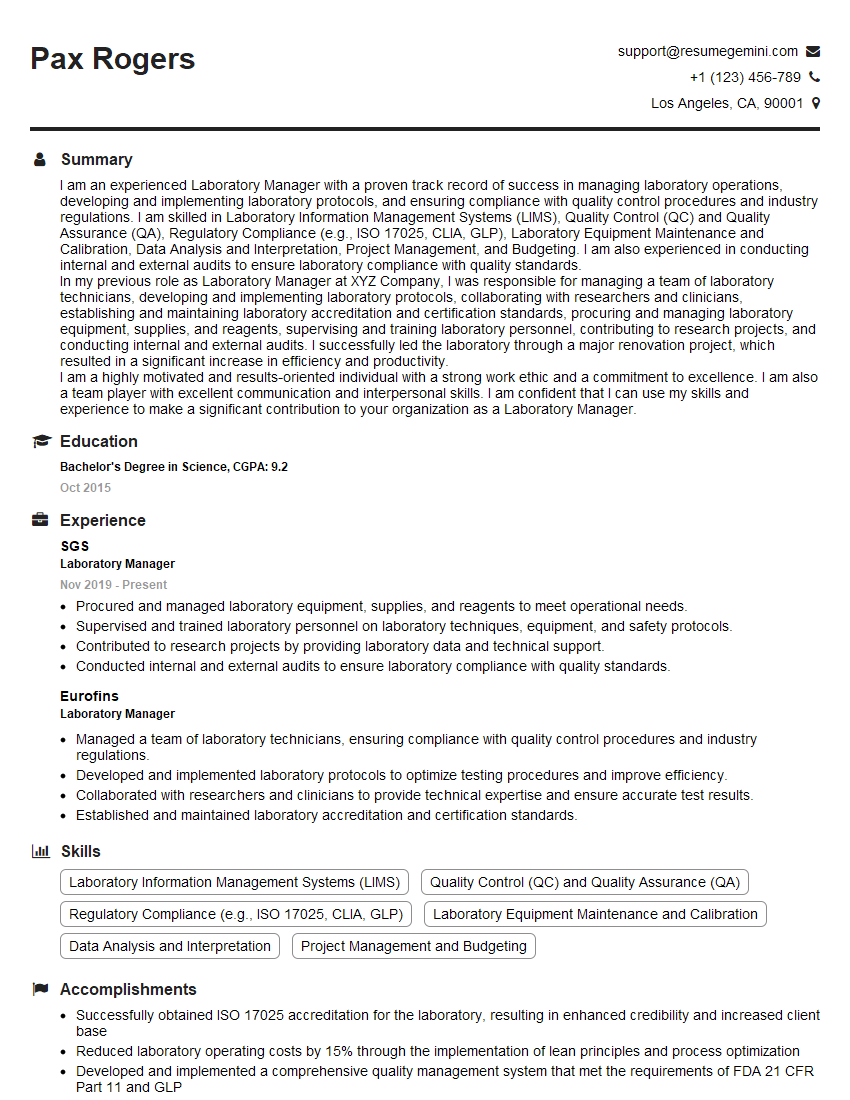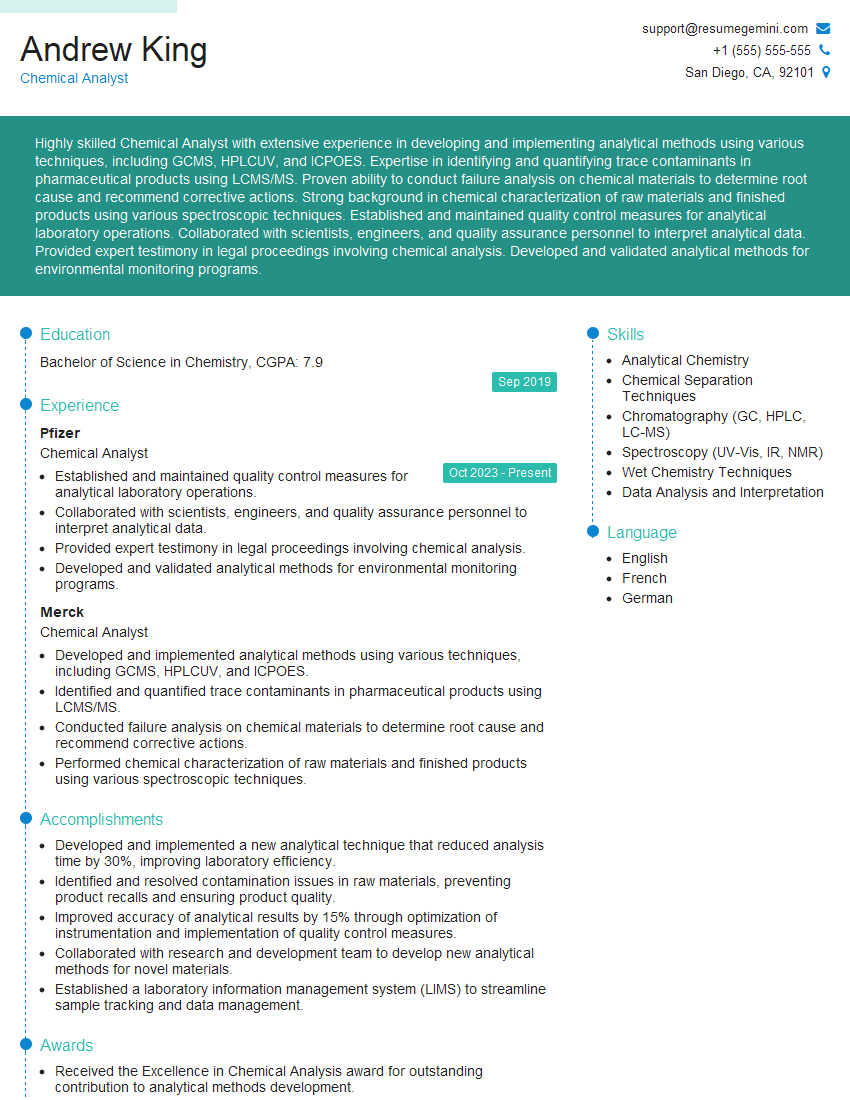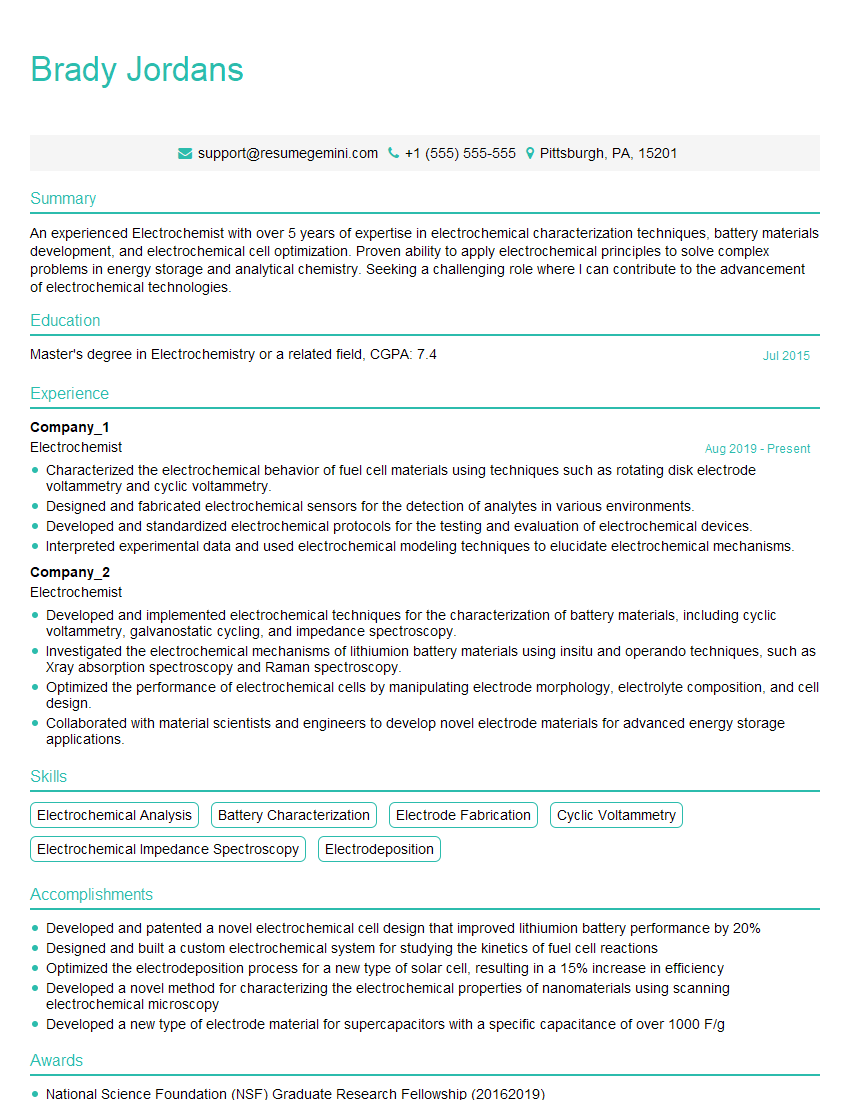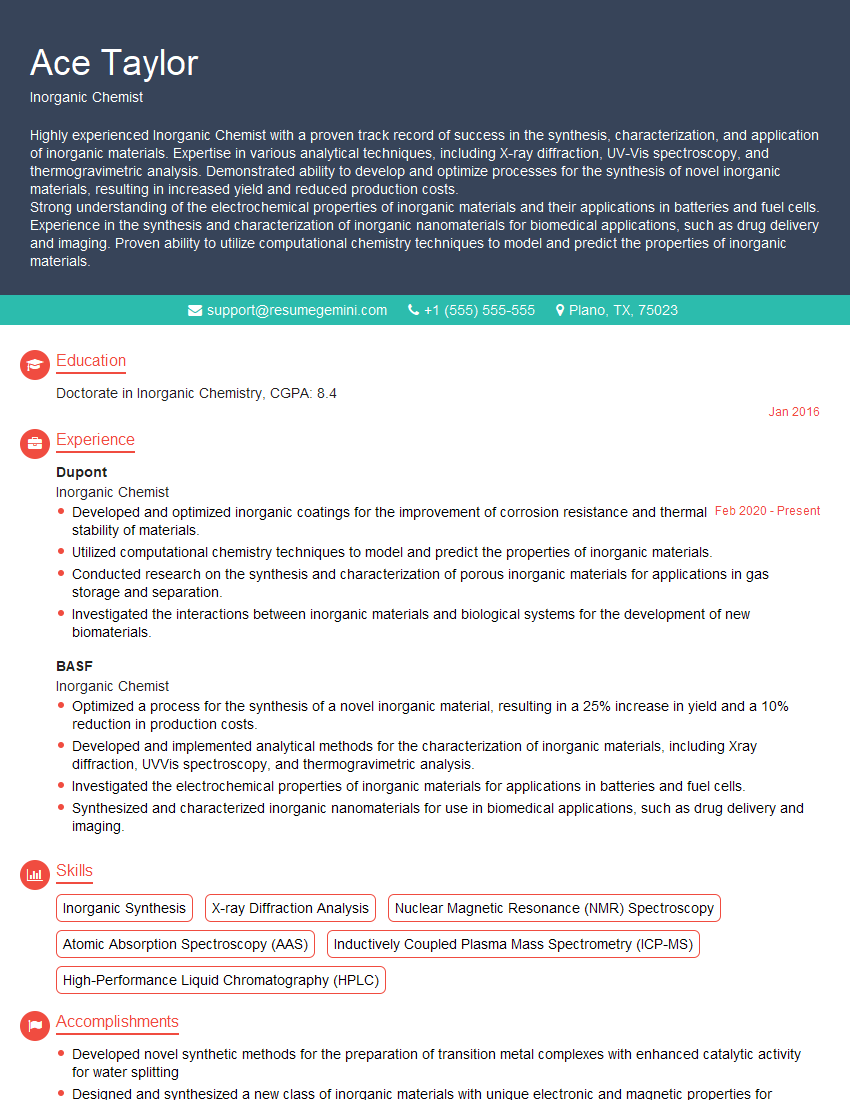Unlock your full potential by mastering the most common Inorganic Chemical Analysis interview questions. This blog offers a deep dive into the critical topics, ensuring you’re not only prepared to answer but to excel. With these insights, you’ll approach your interview with clarity and confidence.
Questions Asked in Inorganic Chemical Analysis Interview
Q 1. Explain the principles of Atomic Absorption Spectroscopy (AAS).
Atomic Absorption Spectroscopy (AAS) is a quantitative technique used to determine the concentration of a specific element in a sample. It’s based on the principle that atoms of each element absorb light at characteristic wavelengths. Think of it like a fingerprint for each element.
The process involves atomizing the sample (turning it into a gas of individual atoms) in a flame or graphite furnace. A light beam from a hollow cathode lamp, specific to the element being analyzed, is passed through the atomized sample. The atoms absorb some of this light at their characteristic wavelengths. The amount of light absorbed is directly proportional to the concentration of the element in the sample. A detector measures the amount of light transmitted, and this data is used to calculate the concentration.
For instance, if we’re measuring lead in water, we’d use a lead hollow cathode lamp. The more lead in the water sample, the more light at the lead’s characteristic wavelength will be absorbed.
Q 2. Describe the different types of chromatography used in inorganic analysis.
Chromatography plays a crucial role in separating and analyzing inorganic components. Several types are employed, each with its advantages:
- Gas Chromatography (GC): Separates volatile compounds based on their differential partitioning between a mobile gas phase and a stationary phase. It’s useful for analyzing volatile metal-containing compounds.
- High-Performance Liquid Chromatography (HPLC): Separates compounds based on their interactions with a stationary phase and a liquid mobile phase. Different HPLC types, like ion-exchange or size-exclusion chromatography, are suitable for various inorganic species.
- Ion Chromatography (IC): A specialized type of HPLC particularly suited for separating ions (cations and anions). It uses ion-exchange resins as the stationary phase and is extremely valuable in environmental monitoring, for example, measuring chloride and nitrate in water samples.
- Supercritical Fluid Chromatography (SFC): Uses supercritical fluids (e.g., supercritical CO2) as the mobile phase. It offers advantages over both GC and HPLC, allowing for the analysis of a wider range of compounds.
The choice of chromatography depends on the properties of the analyte and the complexity of the sample matrix.
Q 3. What are the advantages and disadvantages of Inductively Coupled Plasma Mass Spectrometry (ICP-MS)?
Inductively Coupled Plasma Mass Spectrometry (ICP-MS) is a powerful technique for multi-elemental analysis, offering both high sensitivity and wide dynamic range.
Advantages:
- High sensitivity: Can detect trace elements at very low concentrations (ppb and even ppt levels).
- Multi-elemental capability: Can simultaneously analyze many elements in a single run, saving time and resources.
- Isotope ratio measurements: Provides information on isotopic abundances, useful in isotopic tracing and geochemistry.
Disadvantages:
- Cost: ICP-MS instruments are expensive to purchase and maintain.
- Matrix effects: The sample matrix can interfere with the ionization process, requiring careful sample preparation and potentially the use of internal standards.
- Polyatomic interferences: Formation of polyatomic ions can interfere with the detection of certain elements.
Despite the disadvantages, the power and versatility of ICP-MS make it an indispensable tool in many fields, such as environmental monitoring, food safety, and geological analysis.
Q 4. How do you prepare a sample for X-ray fluorescence (XRF) analysis?
Sample preparation for X-ray fluorescence (XRF) analysis is crucial for accurate results. The goal is to present a homogenous sample that is representative of the bulk material. The method varies depending on the sample type:
- Solid samples: Often require grinding to a fine powder to ensure homogeneity. Pressing the powder into a pellet or fusing it with a flux (like borate glass) can improve the analytical signal.
- Liquid samples: Can be analyzed directly if the matrix is compatible, or they might require dilution or drying onto a suitable substrate.
- Powders: Loose powders might need to be pressed into pellets to create a uniform surface for analysis.
Contamination is a significant concern; all steps must be taken in a clean environment to avoid introducing foreign elements. The method chosen depends heavily on the material being analyzed. For example, a geological sample would require different preparation than a paint sample. The process often involves rigorous quality control checks to ensure the sample is truly representative.
Q 5. Explain the principle of potentiometry and its applications in inorganic analysis.
Potentiometry is an electrochemical method used to measure the potential difference between two electrodes in an electrochemical cell. This potential is directly related to the activity or concentration of a specific ion in the solution. Think of it as a highly sensitive voltmeter for ions.
A common example is a pH meter, which measures the hydrogen ion activity (pH). It uses a glass electrode that is sensitive to H+ ions and a reference electrode with a stable potential. The difference in potential between these electrodes is proportional to the pH.
Applications in inorganic analysis include:
- pH measurements: Determining acidity and alkalinity in various samples.
- Ion-selective electrode (ISE) measurements: Measuring the concentration of specific ions like Na+, K+, Ca2+, Cl-, and F-.
- Redox titrations: Monitoring the change in potential during a redox reaction to determine the concentration of an analyte.
Potentiometry is highly versatile, relatively inexpensive, and widely used in various fields, including environmental monitoring, clinical chemistry, and industrial process control.
Q 6. Describe different methods for determining metal ions in solution.
Several methods can determine metal ions in solution, each with its strengths and limitations:
- Atomic Absorption Spectroscopy (AAS): Highly sensitive and specific for individual elements.
- Inductively Coupled Plasma Optical Emission Spectrometry (ICP-OES): Excellent for multi-elemental analysis, offering high sensitivity and good precision.
- Inductively Coupled Plasma Mass Spectrometry (ICP-MS): Provides superior sensitivity for trace elements and the ability to measure isotopic ratios.
- Titration: A classic method, particularly useful for determining the total concentration of certain metal ions using chelating agents (e.g., EDTA).
- Electrochemical methods (Potentiometry, Voltammetry): These techniques can provide selective measurements of specific metal ions.
- Colorimetric methods: Relatively simple methods based on the color change of a reagent upon reaction with metal ions, suitable for educational purposes or less complex settings.
The best method depends on factors such as the concentration of the metal ions, the presence of interfering substances, and the resources available. For example, if high sensitivity is required, ICP-MS is preferred. But if cost-effectiveness is prioritized, a simple colorimetric method might suffice, provided it satisfies the required accuracy.
Q 7. How do you identify and quantify anions in an unknown sample?
Identifying and quantifying anions in an unknown sample often involves a combination of techniques:
- Ion Chromatography (IC): The primary method for separating and quantifying anions. Different types of columns are used to resolve a wide range of anions, including halides, nitrates, phosphates, and sulfates.
- Qualitative tests: Preliminary tests, such as precipitation reactions, can provide hints about the presence of specific anions. For example, adding silver nitrate to a solution can indicate the presence of chloride, bromide, or iodide ions due to the formation of precipitates.
- Spectroscopic methods (e.g., FTIR): Can provide additional information about the functional groups present, helping to identify anions.
A typical workflow involves initially performing qualitative tests to narrow down the possibilities, followed by quantitative analysis using IC to determine the concentrations of the identified anions. For example, if a sample is suspected to contain chloride and nitrate, a qualitative test would provide initial confirmation, and IC would determine the exact concentration of each.
Q 8. What are the common interferences encountered in flame atomic emission spectroscopy (FAES)?
Flame atomic emission spectroscopy (FAES) is a powerful technique, but its sensitivity can be hampered by various interferences. These can broadly be classified into spectral and chemical interferences.
Spectral interferences arise when the emission lines of an analyte overlap with those of another element present in the sample. For instance, if you’re analyzing sodium, the presence of potassium can interfere because their emission lines are relatively close. This overlap leads to inaccurate measurements as the instrument cannot distinguish between the two signals. One way to mitigate this is to use a high-resolution spectrometer which can better separate the spectral lines.
Chemical interferences occur when the analyte’s emission is affected by its chemical environment in the flame. For example, the formation of refractory compounds (compounds that are difficult to break down in the flame) can reduce the atomization of the analyte, leading to a lower signal. Calcium, in the presence of phosphate, forms a stable phosphate compound, thereby reducing the calcium signal significantly. This interference can be reduced using techniques such as the addition of releasing agents (e.g., lanthanum chloride) which compete with the analyte for the interfering ion, or using a hotter flame to better atomize the sample. Another example is ionization interference where easily ionizable elements affect the ionization equilibrium of the analyte in the flame.
Understanding and mitigating these interferences is crucial for obtaining accurate and reliable FAES results. Careful sample preparation and the selection of appropriate instrumental parameters are key.
Q 9. Explain the principle of gravimetric analysis and give an example.
Gravimetric analysis is a classical quantitative technique where the analyte of interest is separated from the sample and converted into a compound of known composition, which is then weighed. The mass of this compound is used to calculate the amount of analyte originally present. Imagine it like this: you have a batch of cookies, and you want to know the exact weight of the chocolate chips. Gravimetric analysis would be like carefully separating all the chocolate chips, drying them to remove any moisture, and then weighing them. This weight directly gives you the mass of chocolate chips.
A common example is the determination of chloride ions in a sample. The chloride ions are precipitated as silver chloride (AgCl) by adding silver nitrate (AgNO3) solution. The precipitate is then filtered, washed, dried, and weighed. Knowing the molar mass of AgCl, the mass of AgCl obtained allows us to calculate the original amount of chloride ions in the sample.
Mass of AgCl obtained * (Molar mass of Cl / Molar mass of AgCl) = Mass of Cl
This method relies heavily on the complete precipitation of the analyte and the accurate weighing of the final product. Purity of the final precipitate is also critical, often requiring multiple washing steps to eliminate any co-precipitated impurities.
Q 10. What are the safety precautions when working with strong acids and bases?
Working with strong acids and bases demands stringent safety protocols to prevent accidents and injuries. Remember the mantra: prevention is key.
- Eye protection: Always wear safety goggles or a face shield. A splash of concentrated acid or base can cause severe eye damage.
- Protective clothing: Wear a lab coat and gloves made of a chemically resistant material (e.g., nitrile or neoprene). Spills can occur, and the skin needs protection.
- Ventilation: Work in a well-ventilated area or under a fume hood, especially when dealing with volatile acids or bases. Many strong acids and bases produce harmful fumes.
- Slow additions: When diluting strong acids or bases, always add the acid or base slowly to water, while stirring continuously. Never add water to acid or base—this can cause a violent exothermic reaction and splashing.
- Neutralization procedures: In case of spills, know the appropriate neutralization procedure for the specific chemical and how to handle it safely. For acid spills, sodium bicarbonate might be used, while for base spills, dilute acetic acid may be used, but the specific procedure should be outlined in your laboratory’s safety guidelines.
- Proper disposal: Always follow your institution’s guidelines for the safe disposal of strong acids and bases. Never pour them down the drain.
Always follow your laboratory’s safety guidelines and procedures. Safety training is mandatory and should be regularly updated.
Q 11. How do you calculate the limit of detection (LOD) and limit of quantitation (LOQ)?
The limit of detection (LOD) and limit of quantitation (LOQ) are crucial parameters that define the sensitivity and reliability of an analytical method. They represent the lowest concentration of an analyte that can be reliably detected and quantified, respectively.
The LOD is typically calculated as three times the standard deviation of the blank (σblank) divided by the slope (m) of the calibration curve:
LOD = 3.3 * σblank / m
The LOQ is usually calculated as ten times the standard deviation of the blank divided by the slope of the calibration curve:
LOQ = 10 * σblank / m
The blank represents a sample that is free from the analyte of interest. The standard deviation of the blank reflects the variability in the measurement system. The slope of the calibration curve shows the sensitivity of the method—a steeper slope indicates higher sensitivity.
These calculations provide estimates of the LOD and LOQ. The actual values might vary depending on the instrument, matrix effects, and other experimental conditions. It’s important to verify these values through appropriate validation experiments.
Q 12. Explain the concept of standard addition method and when it’s useful.
The standard addition method is a powerful technique used in analytical chemistry to correct for matrix effects in a sample. Matrix effects refer to interferences caused by other components in the sample that might affect the signal of the analyte. Think of it like trying to hear a specific instrument in an orchestra – the other instruments can make it hard to isolate the sound of the one you’re looking for.
In the standard addition method, known amounts of the analyte are added to aliquots of the sample. The resulting solutions are then analyzed. A calibration graph is plotted with the added analyte concentration versus the response (e.g., absorbance, emission intensity), and the graph is extrapolated back to the x-axis where the response equals the response of the original sample. The negative x-intercept is the concentration of the analyte in the original sample.
This method is particularly useful when the sample matrix significantly affects the analytical signal of the instrument. For example, if you’re analyzing heavy metals in soil, the soil matrix can significantly impact the efficiency of the measurement technique. The standard addition method compensates for these effects, leading to a more accurate determination of the analyte concentration.
Q 13. What are the different types of calibration curves used in quantitative analysis?
Several types of calibration curves are used in quantitative analysis, each with its own advantages and disadvantages:
- Linear calibration curve: This is the most common type, where the response is linearly proportional to the concentration of the analyte over a certain range. It’s simple to construct and interpret but may not be suitable for all analytes or concentration ranges.
- Quadratic calibration curve: Used when the relationship between the response and concentration is not linear. It’s described by a second-order polynomial equation and accounts for curvature in the response.
- Polynomial calibration curve: A generalization of quadratic, allowing for higher-order polynomial fits. This handles even more complex non-linear relationships but carries a risk of overfitting.
- Non-linear calibration curve: This encompasses various non-linear models, like exponential or logarithmic curves, depending on the relationship between concentration and response.
The choice of calibration curve depends on the analyte, the analytical technique, and the concentration range being investigated. It’s essential to select a curve that best fits the experimental data and provides accurate and reliable results.
Q 14. How do you ensure the accuracy and precision of your analytical results?
Ensuring the accuracy and precision of analytical results is paramount in any chemical analysis. It requires a multi-pronged approach:
- Proper calibration: Regular calibration of the instruments using certified reference materials is crucial. This ensures that the instrument is responding accurately to the analyte’s signal.
- Method validation: Thorough validation of the analytical method, including determining its accuracy, precision, linearity, LOD, LOQ, and robustness, is essential to demonstrate its reliability.
- Quality control samples: The use of quality control samples (known concentrations) throughout the analysis provides a continuous check on the accuracy and precision of the measurements. Any significant deviation from the expected values highlights potential problems.
- Blank samples: Running blank samples (samples without the analyte) helps to identify and correct for background interference.
- Replicate measurements: Performing multiple replicate measurements helps assess the precision of the method and estimate the uncertainty associated with the results.
- Standard operating procedures (SOPs): Adhering to established SOPs ensures that the analysis is conducted consistently and reproducibly. This minimizes random error.
- Regular maintenance of equipment: Properly maintained instruments are essential for accurate and reliable results. Regular cleaning and calibration minimize instrument-related errors.
By implementing these practices, we can build confidence in the validity of our experimental results. Good laboratory practices are foundational to generating trustworthy data.
Q 15. Describe the process of validating an analytical method.
Method validation in inorganic chemical analysis is crucial to ensure the reliability and accuracy of our results. It’s a systematic process demonstrating that an analytical method is suitable for its intended purpose. This involves several key stages.
- Specificity: We must confirm the method only measures the target analyte, not interfering substances. For example, if we’re measuring lead in water, we need to ensure other metals don’t give false positives. This often involves techniques like using specific selective electrodes or chromatography with effective separation.
- Linearity: The method’s response should be proportional to the concentration of the analyte over a specific range. We’d typically construct a calibration curve and assess its linearity using statistical methods like linear regression. A poor linearity means inaccurate quantification.
- Accuracy: This refers to how close the measured value is to the true value. We assess accuracy through recovery studies, where we spike known amounts of analyte into a sample matrix and compare the measured value to the expected value. For example, we might add 1ppm of arsenic to a water sample and see how closely our analysis reflects that concentration.
- Precision: This refers to the reproducibility of the method. We evaluate precision by performing replicate analyses of the same sample and calculating the standard deviation. Lower standard deviations indicate better precision. This tells us how consistent our measurements are.
- Limit of Detection (LOD) and Limit of Quantification (LOQ): These parameters define the lowest concentration of an analyte that can be reliably detected and quantified, respectively. We determine these limits statistically using the noise of the instrument and the slope of the calibration curve.
- Robustness: This is the method’s ability to remain unaffected by small variations in parameters like temperature, reagent concentration, or sample preparation. This is tested by intentionally introducing small changes and observing their effects on the results.
A well-validated method provides confidence in our analytical data, essential for making informed decisions in various applications such as environmental monitoring, quality control in manufacturing, and forensic science.
Career Expert Tips:
- Ace those interviews! Prepare effectively by reviewing the Top 50 Most Common Interview Questions on ResumeGemini.
- Navigate your job search with confidence! Explore a wide range of Career Tips on ResumeGemini. Learn about common challenges and recommendations to overcome them.
- Craft the perfect resume! Master the Art of Resume Writing with ResumeGemini’s guide. Showcase your unique qualifications and achievements effectively.
- Don’t miss out on holiday savings! Build your dream resume with ResumeGemini’s ATS optimized templates.
Q 16. Explain the importance of quality control in inorganic chemical analysis.
Quality control (QC) is the backbone of reliable inorganic chemical analysis. It’s a systematic process to ensure the accuracy, precision, and reliability of analytical results. QC minimizes errors and maintains data integrity. In practice, this involves several key steps:
- Use of certified reference materials (CRMs): CRMs are materials with known compositions, allowing us to verify the accuracy of our methods. Analyzing CRMs alongside our samples acts as an independent check. Think of it as a calibration tool for our whole process.
- Regular calibration of instruments: Instruments need periodic calibration using standards of known concentration to maintain accuracy. This is especially crucial for techniques like Atomic Absorption Spectroscopy (AAS) or Inductively Coupled Plasma Optical Emission Spectrometry (ICP-OES).
- Blank analysis: A blank sample (containing only the reagents and solvents) is analyzed to detect any contamination or background signals. This helps subtract any interference from our actual sample analysis.
- Duplicate analysis: Analyzing the same sample multiple times allows us to assess the precision of the method. High variability points to potential problems with the technique or the sample handling.
- Spike recovery: Adding a known amount of analyte to a sample and then re-analyzing it helps evaluate the accuracy of the entire analytical process.
- Control charts: These graphical tools help us monitor the performance of the analytical process over time, identifying potential drifts or systematic errors.
Without robust QC, the results of our analyses are unreliable, leading to potentially disastrous consequences, for instance, in environmental monitoring where inaccurate readings might lead to incorrect remediation strategies, or in clinical analysis where inaccurate results can have critical health implications.
Q 17. What is the difference between accuracy and precision?
Accuracy and precision are both critical aspects of analytical quality, but they represent different characteristics. Imagine you’re trying to hit the bullseye on a dartboard.
- Accuracy refers to how close the measurements are to the true value (the bullseye). High accuracy means the average of your measurements is very near the center.
- Precision refers to the reproducibility or closeness of multiple measurements to each other. High precision means your darts are all clustered together, regardless of whether they are close to the bullseye.
You can have high precision but low accuracy (all your darts are clustered together but far from the bullseye), high accuracy but low precision (darts scattered around the bullseye), or ideally, both high accuracy and high precision (darts clustered tightly around the bullseye). In analytical chemistry, we strive for both. For example, in quantifying a metal in a sample, a precise method consistently gives similar values, while an accurate method gives a value close to the true concentration.
Q 18. How do you troubleshoot instrument malfunctions in common analytical techniques?
Troubleshooting instrument malfunctions requires a systematic approach. The specific steps depend on the instrument and the nature of the problem, but here’s a general strategy:
- Identify the problem: Start by clearly defining the malfunction. Is it an unexpected signal, a lack of signal, unusual noise, or a calibration issue?
- Check the obvious: Before jumping to complex issues, ensure basic things are correct. Is the instrument switched on? Are reagents fresh? Are the connections secure? Is the sample properly prepared?
- Consult the instrument manual: Instrument manuals are invaluable resources. They often include troubleshooting sections, error codes, and maintenance procedures.
- Check calibration and standards: If the problem relates to quantification, verify the calibration standards are accurate and correctly prepared. Recalibration might solve the issue.
- Inspect components: If the manual suggests potential physical issues, carefully inspect components for damage, leaks, or blockages. For example, in chromatography, a clogged column can lead to poor results.
- Seek technical support: If the problem persists, seek help from the manufacturer or a qualified service technician. Providing detailed information about the malfunction, error messages, and the steps already taken will aid in effective troubleshooting.
For example, if an AAS flame is unstable, you might check the gas flow rates, the atomizer position, or the condition of the burner head. A systematic approach helps efficiently pinpoint and resolve the cause.
Q 19. Describe your experience with data analysis and interpretation in inorganic chemistry.
My experience with data analysis and interpretation in inorganic chemistry is extensive. I’m proficient in using various statistical software packages such as R and Excel to analyze data from different analytical techniques.
- Data Cleaning and Preprocessing: This includes handling outliers, identifying and correcting errors, and transforming data (e.g., logarithmic transformations).
- Calibration Curve Analysis: I routinely construct and evaluate calibration curves, determining linearity, sensitivity, and limits of detection and quantification. This involves techniques like linear regression and weighted least squares.
- Statistical Analysis: I perform t-tests, ANOVA, and other statistical tests to assess the significance of differences between groups, compare methods, and evaluate the uncertainty associated with my measurements.
- Quality Control Charts: I use control charts (e.g., Shewhart charts, CUSUM charts) to monitor the performance of the analytical process and detect systematic errors.
- Data Visualization: I use various graphical methods (e.g., histograms, scatter plots, box plots) to visualize data, identify trends, and communicate results effectively.
In my previous role, I used statistical methods to identify and quantify trace metals in environmental samples. Through careful data analysis, I successfully demonstrated a statistically significant increase in heavy metal concentration downstream of an industrial plant, supporting environmental impact assessments.
Q 20. Explain your experience with different types of laboratory equipment.
My experience encompasses a wide range of laboratory equipment used in inorganic chemical analysis. This includes:
- Spectroscopic techniques: I’m proficient with Atomic Absorption Spectroscopy (AAS), Inductively Coupled Plasma Optical Emission Spectrometry (ICP-OES), and Inductively Coupled Plasma Mass Spectrometry (ICP-MS) for elemental analysis. I understand the principles behind these techniques, their strengths and limitations, and their applications in various fields.
- Chromatographic techniques: I have experience with High-Performance Liquid Chromatography (HPLC) and Gas Chromatography (GC) coupled with various detectors (e.g., UV-Vis, fluorescence, mass spectrometry) for the separation and analysis of inorganic compounds.
- Electrochemical techniques: I’m familiar with potentiometry, voltammetry, and other electrochemical techniques for determining the concentration of ions in solution.
- Other equipment: My experience also includes the use of balances, pH meters, spectrophotometers, furnaces, and various other common laboratory equipment. I understand proper handling and maintenance procedures for all equipment.
Beyond technical proficiency, I understand the importance of calibration, maintenance, and troubleshooting. I’m also adept at selecting the appropriate equipment based on the specific analytical challenge.
Q 21. How would you handle a discrepancy in analytical results?
Discrepancies in analytical results require a thorough investigation. My approach involves a systematic process:
- Review the data: Start by carefully examining the data, looking for patterns or anomalies. Are the discrepancies random or systematic? Are there outliers?
- Check the sample preparation: Ensure the samples were properly prepared and handled. Were there any potential sources of contamination or loss during sample preparation?
- Verify instrument calibration and performance: Ensure the instrument was properly calibrated and functioning correctly. Check calibration standards and blank runs. A poorly calibrated instrument can lead to systematic errors.
- Repeat the analysis: Repeat the analysis on the same sample or a fresh sample. If the discrepancy persists, this suggests a potential problem with the method or the sample itself.
- Investigate potential interferences: Check for any potential interferences in the sample that could affect the results. This often requires a deeper understanding of the chemical processes involved.
- Consult literature: Review relevant literature to see if others have experienced similar problems or if there are alternative methods that could be used.
- Assess uncertainty: Finally, consider the uncertainty associated with the measurements. Statistical analysis can help assess if the difference is significant or simply due to random error.
In one instance, a discrepancy in metal concentration measurements was traced back to insufficient digestion of the sample matrix, leading to incomplete dissolution of the analyte. Thorough investigation is key to resolving such discrepancies and ensuring reliable results.
Q 22. Describe your experience with method development and validation.
Method development and validation are crucial steps in ensuring the reliability and accuracy of any analytical method. Development involves designing a new method or adapting an existing one to meet specific needs, while validation confirms its suitability for its intended purpose. My experience encompasses the entire lifecycle, from initial method selection based on the analyte and matrix, through optimization, to rigorous validation following regulatory guidelines.
For example, I recently developed a new inductively coupled plasma mass spectrometry (ICP-MS) method for the determination of trace elements in environmental water samples. This involved selecting appropriate sample preparation techniques (e.g., acid digestion), optimizing instrument parameters (e.g., plasma power, nebulizer gas flow), and evaluating potential interferences. The validation process included assessing parameters like linearity, accuracy, precision, limit of detection (LOD), and limit of quantification (LOQ), using certified reference materials and control samples. The entire process was meticulously documented, following internationally recognized standards.
Another project involved adapting a standard spectrophotometric method for determining iron concentration in soil samples. This required careful consideration of matrix effects and the development of a robust calibration strategy to account for variations in sample composition. We employed matrix-matched calibration standards and explored different pre-treatment methods to minimize interference, ultimately demonstrating the reliability and accuracy of the modified method.
Q 23. How familiar are you with Good Laboratory Practices (GLP)?
I am very familiar with Good Laboratory Practices (GLP). GLP is a set of principles that ensure the quality and reliability of non-clinical laboratory studies. My understanding encompasses all aspects, from proper sample handling and storage to detailed record keeping, equipment calibration, and quality control procedures. I’ve consistently worked within a GLP framework throughout my career, adhering to the principles of quality assurance and maintaining meticulous documentation. This includes detailed standard operating procedures (SOPs), regular instrument calibration and maintenance logs, and thorough review of all data. Compliance is paramount; it’s not just about following rules, but understanding the rationale behind them to ensure the integrity of the analytical results.
For instance, in one project involving the analysis of pesticides in food samples, meticulous adherence to GLP was crucial for regulatory compliance and acceptance of the analytical results. Any deviation from the SOPs, no matter how minor, was meticulously recorded and explained. Regular audits ensured we were consistently meeting GLP standards. This rigorous approach guarantees data reliability and transparency, critical for any analytical study, particularly when used for regulatory submissions.
Q 24. What are the different types of inorganic samples you have analyzed?
My experience with inorganic sample analysis is extensive and diverse. I’ve worked with a broad range of matrices, including environmental samples (water, soil, air particulate matter), geological samples (rocks, minerals, ores), biological samples (plant tissues, animal tissues), and industrial materials (alloys, catalysts). The specific analytes have ranged from major components to trace elements, depending on the nature of the analysis.
- Environmental Samples: Analysis of heavy metals (e.g., Pb, Cd, Hg) in water and soil, often requiring pre-concentration techniques and specialized sample preparation methods.
- Geological Samples: Determining the composition of minerals and ores using various techniques such as X-ray fluorescence (XRF) and ICP-OES/MS.
- Biological Samples: Analyzing essential and toxic trace elements in biological tissues using techniques like atomic absorption spectrometry (AAS) and ICP-MS.
- Industrial Materials: Elemental analysis of alloys to determine their composition and ensure quality control, often involving techniques such as XRF and AAS.
Q 25. How do you ensure the quality and integrity of your samples?
Ensuring sample quality and integrity is fundamental to reliable analytical results. This begins with proper sampling procedures, taking into account potential contamination and ensuring representative samples are collected. Samples must be handled carefully to prevent contamination, loss, or degradation. Specific measures include the use of clean containers, appropriate storage conditions (temperature, light exposure), and proper chain of custody documentation.
For instance, during water sample collection, we use pre-cleaned bottles made of inert materials and rigorously follow protocols to avoid contamination from the sampling equipment or the surroundings. Soil samples are collected using specialized tools and stored in airtight containers to prevent moisture loss or oxidation. Each step, from sampling to analysis, is meticulously documented to maintain traceability and ensure data integrity. The use of certified reference materials and quality control samples at various stages of the analysis further ensures the accuracy and reliability of the results.
Q 26. Explain your experience with statistical analysis of analytical data.
Statistical analysis is integral to inorganic chemical analysis. It’s used to evaluate the quality of analytical data, assess method performance, and draw meaningful conclusions from experimental results. My experience includes applying various statistical methods such as:
- Descriptive statistics: Calculating means, standard deviations, and other descriptive parameters to summarize data.
- Linear regression: Developing and evaluating calibration curves to quantify analytes.
- Analysis of variance (ANOVA): Comparing the means of different groups of data to determine if there are statistically significant differences.
- Quality control charts: Monitoring data quality over time and identifying potential problems.
Software packages like Microsoft Excel, Minitab, and specialized analytical software are regularly used to perform these analyses. For example, in validating a new method, ANOVA is used to compare results obtained from the new method and a reference method. Linear regression is employed to assess the linearity of the calibration curve and determine the limits of detection and quantification. Proper statistical interpretation is essential to ensuring reliable and defensible conclusions from the analytical data.
Q 27. What are the environmental considerations in inorganic chemical analysis?
Environmental considerations are paramount in inorganic chemical analysis. The generation of hazardous waste, such as chemical reagents and contaminated samples, must be minimized. Proper disposal methods must be followed, adhering to all relevant environmental regulations. The selection of analytical methods should prioritize environmentally friendly approaches, such as the use of less toxic reagents and the minimization of solvent usage.
Specific examples include the use of microwave digestion instead of traditional hot plate digestion for sample preparation, significantly reducing energy consumption and minimizing waste. The use of green solvents and reagents wherever possible is also prioritized. Waste management protocols are strictly adhered to, with proper segregation and disposal of hazardous materials in accordance with local, regional and national environmental regulations. Furthermore, instrument maintenance and calibration practices that minimize environmental impact are employed.
Q 28. Describe your proficiency with different software for data acquisition and analysis.
Proficiency with data acquisition and analysis software is a key skill in inorganic chemical analysis. I am adept at using various software packages including:
- ICP-MS software: (e.g., Thermo Scientific Qtegra ISQ, Agilent MassHunter) for instrument control, data acquisition, and processing in ICP-MS analyses.
- ICP-OES software: (e.g., PerkinElmer Syngistix, Agilent ICP Expert) for instrument control, data acquisition, and data processing in ICP-OES analysis.
- AAS software: (e.g., PerkinElmer PinAAcle, Varian SpectrAA) for instrument control and data analysis in atomic absorption spectrometry.
- XRF software: (e.g., PANalytical SuperQ, Rigaku RINT) for instrument control, data acquisition, and quantitative analysis in X-ray fluorescence spectrometry.
- Chromatography software: (e.g., Agilent OpenLab CDS, Waters Empower) for data acquisition and processing when chromatography is coupled with other detection methods (e.g., HPLC-ICP-MS).
- Spreadsheet software: (e.g., Microsoft Excel, LibreOffice Calc) for data manipulation, statistical analysis, and report generation.
I am comfortable with both instrument-specific software and more general-purpose software packages for data analysis and report generation. My skillset allows me to effectively manage, analyze, and interpret large datasets, ensuring accurate and reliable results.
Key Topics to Learn for Inorganic Chemical Analysis Interview
- Qualitative Analysis: Understanding classical methods like precipitation reactions, flame tests, and complexometric titrations. Practical application: Identifying unknown metal ions in a sample.
- Quantitative Analysis: Mastering gravimetric and volumetric techniques, including acid-base titrations, redox titrations, and complexometric titrations. Practical application: Determining the precise concentration of a metal ion in a solution.
- Instrumental Techniques: Familiarizing yourself with the principles and applications of Atomic Absorption Spectroscopy (AAS), Inductively Coupled Plasma Optical Emission Spectrometry (ICP-OES), and other relevant instrumental methods. Practical application: Analyzing trace elements in environmental samples.
- Sample Preparation: Understanding the importance of proper sample preparation techniques, including digestion, dissolution, and extraction. Practical application: Ensuring accurate and reliable analytical results.
- Data Analysis and Interpretation: Developing strong skills in statistical analysis of data, error analysis, and reporting results with appropriate precision and accuracy. Practical application: Drawing meaningful conclusions from experimental data.
- Quality Control and Assurance: Understanding the principles of good laboratory practices (GLP) and quality control procedures in analytical chemistry. Practical application: Ensuring the reliability and validity of analytical results.
- Safety in the Lab: Demonstrating a thorough understanding of safety protocols and handling of hazardous chemicals common in inorganic analysis. Practical application: Maintaining a safe and productive laboratory environment.
Next Steps
Mastering Inorganic Chemical Analysis opens doors to exciting career opportunities in various industries, including environmental monitoring, pharmaceuticals, materials science, and forensics. A strong foundation in this field significantly enhances your employability and allows you to contribute meaningfully to innovative research and development. To maximize your job prospects, it’s crucial to present your skills effectively. Creating an ATS-friendly resume is key to getting your application noticed. ResumeGemini is a trusted resource to help you build a professional and impactful resume. We provide examples of resumes tailored to Inorganic Chemical Analysis to guide you through the process. Invest time in crafting a compelling resume – it’s your first impression with potential employers.
Explore more articles
Users Rating of Our Blogs
Share Your Experience
We value your feedback! Please rate our content and share your thoughts (optional).
What Readers Say About Our Blog
Live Rent Free!
https://bit.ly/LiveRentFREE
Interesting Article, I liked the depth of knowledge you’ve shared.
Helpful, thanks for sharing.
Hi, I represent a social media marketing agency and liked your blog
Hi, I represent an SEO company that specialises in getting you AI citations and higher rankings on Google. I’d like to offer you a 100% free SEO audit for your website. Would you be interested?










